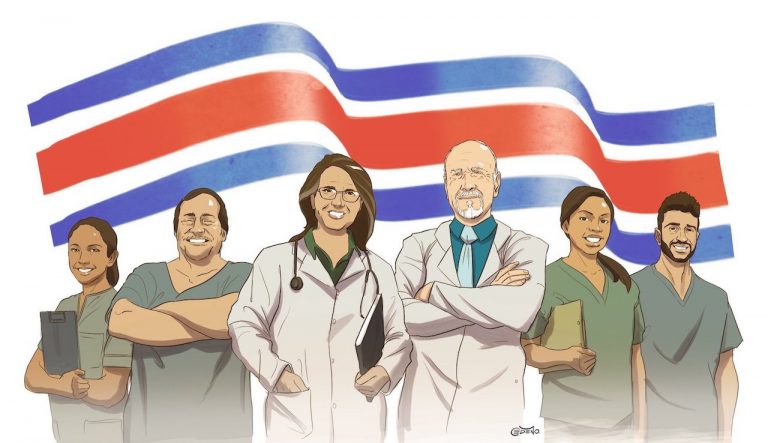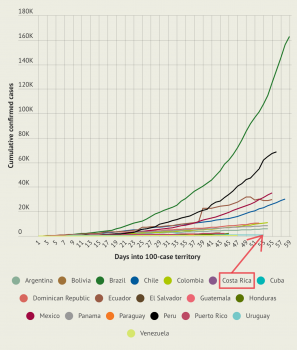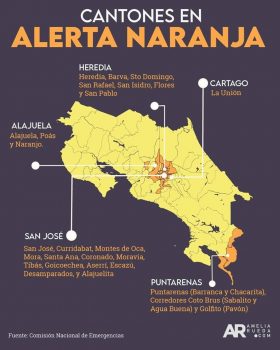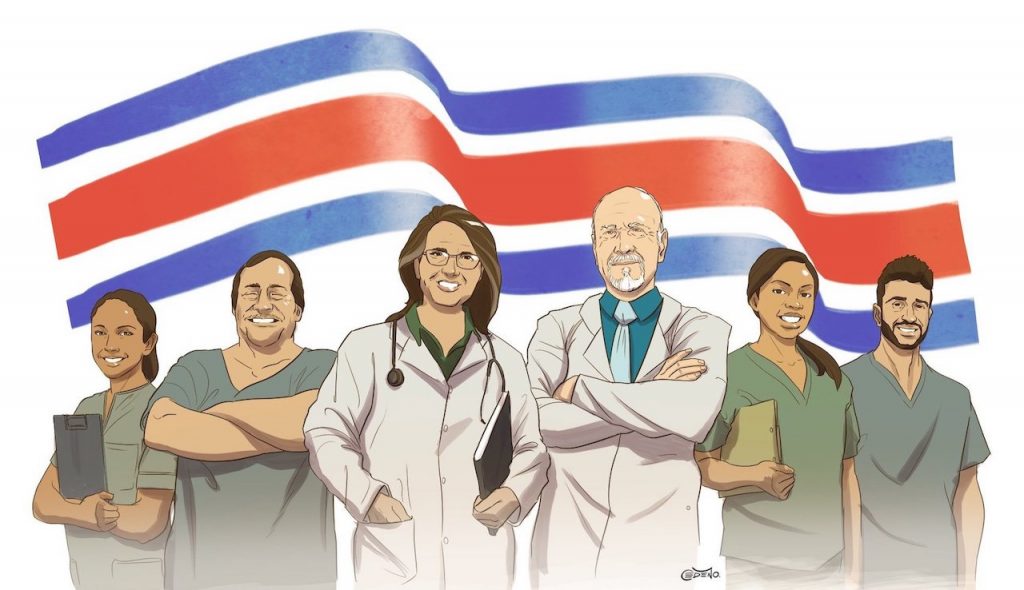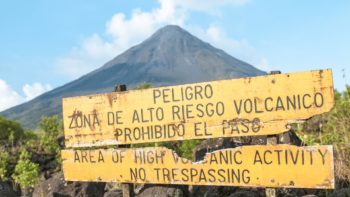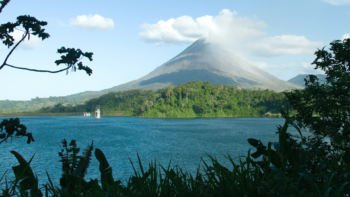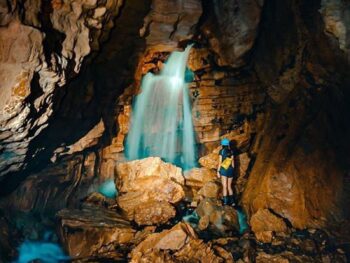August 31
Concerned over COVID-19 and Costa Rica? You shouldn’t be and here’s why.
Costa Rica has been a popular vacation spot since the late 1980s and welcomed 3.139 million tourists in 2019 and 3.016 million the previous year. So it was understandable when the country announced its first case of COVID-19 on March 6 before many of its Latin American neighbors. Three days later, large gatherings were prohibited, and a state of emergency was declared on March 16 when the country registered 41 cases of the virus. Schools were closed and restrictions placed on non-essential businesses. The country announced that it would be closing its borders on March 19 and that only Costa Rican citizens, residents, embassy staff and/or other exemptions would be permitted entry into the country.
Subdued Holy Week
Easter week of March 6 — 10 was considered a high-risk period for infection spread as it is the traditional vacation week for locals. The government combated this by outlining much stricter regulations on vehicle circulation which effectively kept much of the population at home. Beach closures and the reintroduction of the Dry Law in many of the coastal towns forbidding alcohol sales made a trip to either of the country’s shores less appealing.
Beaches and national parks have been closed since March 20 as part of the government’s drive to deter movement from the heavily populated Central Valley area — where medical facilities and staffing are more prepared to deal with a wave of medical emergencies than the rural hospitals in the rest of the country.
One [license plate] to rule them all
Costa Rica’s constitution guarantees its citizens freedom of movement so the introduction of curfews or other restrictions to prevent people traveling across the country was impossible. Unlike neighboring Panama which reduced movement by only allowing men and women to leave their homes on different days, Costa Rica’s lawmakers dodged the constitutional headache by introducing road circulation restrictions based on the last digit on the license plate and restricting hours when vehicles could drive. These restrictions were then tightened over the weekends when vehicles are restricted to driving either Saturdays or Sundays to either the supermarket or pharmacy. With license plate confiscation, a fine, and points on the driver’s license as consequences for driving outside of permitted times, the restrictions have been largely effective.
Testing and results
As of May 12th, Costa Rica has tested almost 17,470 people and reported 804 positive cases of the virus with only seven deaths. As the President pointed out, the low mortality rate of 0.87% is due in part to Costa Rica’s investment into universal healthcare, social security and education since abolishing its army over 70 years ago.
Supported by the country’s respected Health Minister, Daniel Salas, who is a qualified surgeon and epidemiologist; the country has been guided by science in its decision making and received factual and informative briefings daily on numbers and any changes to restrictions. Check out their Twitter feed for daily data reporting.
Per the Costa Rican Minister of Health’s figures, May 21 brought the total test numbers to 21,929 with 903 confirmed cases, 592 recoveries, and 10 deaths.
As of May 28th, Costa Rica reported 16 new cases to bring the number of confirmed cases to 1,000 although this total includes 646 people who have fully recovered. Latin America has taken the unenviable title of being the current center of the virus due to the rapid spread in Brazil especially but Costa Rica hopes that maintaining careful social distancing can ensure that the virus does not take hold over the country.
Update: Costa Rica’s numbers have continued to be much lower than its Central American neighbors. Up until the 31st of July, the country had reported a total of 17,820 cases and 150 deaths. The Government’s “hammer and dance” approach to localized lockdowns for areas where high numbers of active cases have been reported and further conversion of hospital wards for dedicated COVID care have ensured that the continued health crisis has remained under control while much of the country moves into further stages of reopening.
They’re singing our praises
International news sources such as the BBC, ABC and CNTraveler have applauded Costa Rica’s successful efforts in managing COVID-19 within the country. With the lowest mortality rate for the virus in Latin America, the nation is hoping to emerge from this global crisis as an attractive vacation option for tourists eager to get some sun after weeks, if not months, of “stay at home” lockdown. Costa Rica does not have many destinations which attract a high concentration of tourists and its boutique establishments at beach, volcano, and jungle settings are ideal for maintaining social distancing.
Even New Zealand’s success story — which has been picked up by the media, pales in comparison with Costa Rica’s numbers. Prime Minister Ardern’s efforts to quickly bring in strict measures led to the country registering only 1,476 positive cases and 19 deaths; however, Costa Rica has less cases and deaths even though the country’s populations are a similar size.
Social bubbles
Costa Rica has borrowed New Zealand’s concept of Social Bubbles which minimizes the risk of transmission according to Stefan Flasche, the Associate Professor of the London School of Hygiene and Tropical Medicine. The bubbles consist of members of the same household and cannot be mixed with people from other households, work colleagues, or more distant family members.
Tourism? Yes, we’re still here!
The National Chamber of Tourism (ICT) predicts that Costa Rica could still receive 300,000 visitors before the end of 2020 if flights are resumed in August. Airlines will obviously have to introduce social distancing protocols for passengers and measures will be in place to ensure safe entry into the country at airports. The government is fully supporting the Costa Rican Institute of Tourism in its initial publicity to reactivate tourism for nationals before expanding its positive message to welcome international visitors into the country again. Younger visitors are expected to be the first to return to the country as they are less vulnerable to the virus and the ICT will be encouraging pricing throughout the industry to make vacations more affordable to tourists who usually have less disposable income than retirees.
What, if anything, has reopened?
There was some relaxing of measures when the number of reported cases had declined for 11 consecutive days and since May 1, the following businesses were allowed to reopen:
During the week, between 5 AM and 7 PM:
-
- movie theaters at 50% capacity
- non-contact sports facilities and gyms at 25% capacity
During the weekend, between 5 AM and 7 PM:
-
- beauty salons, barbers, and auto-repair shops at 50% capacity
New measures to start gradually opening the national parks, beaches, and hotels will be announced on Monday May 11 although limited hours and visitor numbers are expected for the national parks.
Vehicle restrictions in place since April 13 will continue through May 15 with transit being limited by license plate number between 5 AM and 7 PM and a total vehicle restriction between 7 PM and 5 AM every night. Moving forward, the government will reevaluate the measures every two weeks.
Commerce and restaurants will follow thereafter before Costa Rica prepares to reopen its borders on June 15.
Update: Land borders will remain closed, but air travel will resume officially on August 1st at 11:59 PM.
Large-scale events will be the last step of the process.
President Carlos Alvarado will coordinate with the World Tourism Organization and other bodies to reactivate international tourism in the country with the appropriate protocols in place. He hopes to continue to move Costa Rica forward on its ambitious target of becoming carbon neutral by 2050 despite the economic blow delivered by the virus and considers the situation could provide opportunities for the creation of new sustainable businesses.
What are these ‘bubbles’ you’re talking about?
The concept of Social Bubbles are for public places in order to reduce the spread of the virus.
As such, each bubble should be formed by people who live together and maintain a distance of 1.8 m from other social bubbles.
May 16 — 31
-
- National parks at 50% capacity and with pre-booked entry
- Non-contact recreative sports
- Professional contact sports without spectators
- At the weekends, food can be collected from the takeout window of restaurants
- Hotels with a maximum of 20 rooms can open at 50% capacity
- Beaches will open from 5:00 AM to 8:00 AM Mondays to Fridays
- Physical recreational activities are permitted
June 1 — 20
-
- Restaurants at 50% capacity
- Public parks at 50% capacity
- Museums at 50% capacity and with pre-booked entry
- Other hotels at 50% capacity
June 21 — July 12
-
- Stores at 50% capacity
- Movie theaters and theatres at 50% capacity
- Sport centers for non-contact sports
- Places of worship – maximum of 75 people, maintaining 1.8 meters distance
- Bars at 50% capacity
July 12 — August 1
-
- First, Sixth and Eleventh Grade students return to school with special protocols in place
- Places of worship – maximum of 100 people, maintaining 1.8 meters distance
- Beaches will open while maintaining social bubbles
The new normal begins
The happy news is that Costa Rica’s (air) borders will re-open (technically) on August 1st. For practical purposes, it will be August 2nd and the land borders will remain closed until the situation improves in neighboring countries.
Like you, we’re delighted that travel is possible again and Costa Rica is a perfect post-COVID-19 getaway location — as our tourist destinations are uncrowded and so lend themselves to social distancing — but don’t take our word for it since the Minister of Tourism mentioned in a press conference that Costa Rica received a Seal of Safe Destination to travel during COVID issued by the World Travel and Tourism Council.
The first round will consist of five flights a week, departing from Spain, Germany and Canada.
-
- Specifically, citizens and residents of the EU (including the Schengen Area) or the United Kingdom may board a plane within the EU, any Schengen Area, or UK.
- Furthermore, passengers allowed on flights departing from Canada include the citizens and residents of Canada and the citizens and residents of the European Union, Schengen Area, and the United Kingdom who are in transit.
- Departing from the USA, for now, is on hold.
What this means is that one cannot hop a flight from the United States to Canada and then turn around and fly onward to Costa Rica. For illustrative purposes, a Canadian may not fly from the UK to Costa Rica, but they could if they had left from their home country.
Travelers leaving from one of the designated areas need the following three items, although they may not be verified at check-in. Any outstanding requirements will need to be resolved on arrival in Costa Rica:
-
- Proof of a negative COVID test result within 72 hours [as far as we can discern, this means that the sample has to be taken, the test run, and the results delivered (and translated into either English or Spanish) before one can complete the online form — all of which needs to be completed within a 72-hour window]
- Secure mandatory travel insurance to cover the lodging/medical/travel costs related to the quarantine and/or treatment in the unlikely case the visitor contracts COVID. This insurance can be purchased from an national or international insurer which covers COVID, and carries the minimum $20,000 for medical expenses and $4,000 accommodation costs.
- Completion of the digital epidemiology form online — which includes uploading the negative coronavirus test result as either a PDF or JPG file as well as the insurance policy number. This form is called Pase de Salud. Costa Ricans and residents only need to complete this form; i.e. they do not need to purchase travel insurance nor show proof of a negative test result; however, a 14-day home isolation order will be enforced. At the airport, they will also undergo a medical check.
Upon arrival in Costa Rica, travelers must wear face protection and comply with the strict protocols of the air terminal with regard to physical distancing, disinfection of carpets, and taking temperature readings, and must follow any other sanitary instructions.
Alert levels
As if that weren’t all… There are also areas of color that represent the severity for each canton (municipality) and district; each with their own specific rules.
Yellow Alerts ::
All activities must be carried out in social bubbles and with strict compliance with the ICT and private sector’s health protocols.
Tourism activities allowed :: Starting August 1st, 2020.
-
- Outdoor tours including: walking, hiking, trekking, canopy, cable cars, raft rides, water recreation, aerial recreation.
- Beaches will be open from 5 AM to 2:30 PM. Surfing is allowed.
Reopening slowly in August
Phases have been structured to help with limiting the exposure and spread of the coronavirus.
The “Reopening” phase will be August 1 through August 9, as well as August 22 through August 30. Most commercial businesses (those with sanitary permits) are allowed to operate nationwide.
The “Closing” phase consists of the total closure of all commercial enterprises, who are located in cantons under an Orange Alert, from August 10 through August 21. In cantons under a Yellow Alert, these establishments may continue to operate normally during these dates. The mid-August closing phase will allow health authorities to identify and isolate those who contracted the coronavirus in early August.
The following activities and businesses still cannot operate in August: concerts, public spectacles, fairs (except farmer’s markets), sporting events, expos, conference centers, skate parks and children’s games, amusement parks, bars, nightclubs, and casinos.
Other activities of note:
-
- Mother’s Day is celebrated August 15, which falls in the “closing phase” for Orange Alert cantons.
- In Orange Alert areas: beaches and lakes are open daily from 5-9:30 AM, even during the “closing phase.” National parks can also remain open during the closing phase in both Yellow and Orange Alert areas.
- The International Film Festival and the National Art Festival are not permitted.
- Church and similar religious gatherings of up to 75 people is permitted in the Yellow Alert areas, but not in the Orange Alert areas. Religious processions (e.g. the Romería) are not permitted nationally.
- Public transport can operate regularly in Yellow and Orange Alert areas. This includes long-distance bus routes and special transport for tourists.
Moving (driving) forward in August
For August, the following driving restrictions will be in place for the specific areas, dates, and times.
Please note that rental vehicles are not subject to either the government’s circulation restrictions based on license plate numbers or curfew hours, so our clients can enjoy freedom when driving on their vacation.
Yellow Alert
Driving is allowed from 5:00 AM to 10:00 PM on weekdays; 5:00 AM to 7:00 PM on weekends except:
-
- Plates ending in 1 & 2 cannot drive on Mondays
- Plates ending in 3 & 4 cannot drive on Tuesdays
- Plates ending in 5 & 6 cannot drive on Wednesdays
- Plates ending in 7 & 8 cannot drive on Thursdays
- Plates ending in 9 & 0 cannot drive on Fridays
- Plates ending in even numbers; 0, 2, 4, 6 and 8, cannot drive on Saturday
- Plates ending in odd numbers; 1, 3, 5, 7, and 9, cannot drive on Sunday
Orange Alert for Reopening Phase
Driving is allowed from 5:00 AM to 5:00 PM every day of the week except:
-
- Plates ending in 1 & 2 cannot drive on Mondays
- Plates ending in 3 & 4 cannot drive on Tuesdays
- Plates ending in 5 & 6 cannot drive on Wednesdays
- Plates ending in 7 & 8 cannot drive on Thursdays
- Plates ending in 9 & 0 cannot drive on Fridays
- Plates ending in even numbers; 0, 2, 4, 6 and 8, cannot drive on Saturday
- Plates ending in odd numbers; 1, 3, 5, 7, and 9, cannot drive on Sunday
Orange Alert for Closing Phase
Driving is allowed from 5:00 AM to 5:00 PM every day of the week except:
-
- Only cars with plates ending in 1 & 2 can drive on Mondays
- Only cars with plates ending in 3 & 4 can drive on Tuesdays
- Only cars with plates ending in 5 & 6 can drive on Wednesdays
- Only cars with plates ending in 7 & 8 can drive on Thursdays
- Only cars with plates ending in 9 & 0 can drive on Fridays
- Only cars with plates ending in odd numbers; 1, 3, 5, 7, and 9, can drive on Saturday
- Only cars with plates ending in even numbers; 0, 2, 4, 6 and 8, can drive on Sunday
September marks the reopening to the United States
Costa Rican authorities announced on August 19th, with a follow-up on August 27th, that a further reopening of the country will include welcoming residents from specific U.S. states starting September 1st.
Connecticut, Maine, Maryland, New Hampshire, New Jersey, New York, Vermont, Virginia and the District of Columbia (DC) are the first approved states. In addition to the above listed requirements for non-residents of Costa Rica, these Americans will need to prove that they are residents of the listed states by showing their drivers licenses/state ID; however, minors traveling with a parent will be excluded from this requirement. Colorado, Massachusetts and Pennsylvania residents are welcome to visit starting from September 15th.
Flights will leave from New Jersey’s Newark, and New York’s La Guardia and John F. Kennedy airports four times a week. Guanacaste’s Daniel Oduber Quiros Airport will be reopened for the first time since the country’s shutdown in March. Obviously more airports will come online, but at the moment, this is the information that we have on hand.
Further good news is that visitors may now arrive via a flight with a layover in a non-authorized location. For instance, a Maine resident could fly from Bangor to Costa Rica via Houston, as long as they do not leave the airport in Texas.
Costa Rica’s crisis timeline
For a great in-depth review of how Latin America has responded to COVID-19, please visit the Where Is the Coronavirus in Latin America? article.
TL;DR: The Golden Rules for Costa Rica, as introduced on May 11th, are as follows:
-
- No one with cold or flu symptoms should leave their home.
- People with serious illness that present risk factors if they contract COVI-19 must avoid public places.
- Face masks are now required on public transport and enclosed spaces.
- It is recommended that movement in public places is within social bubbles; i.e. keeping members of a daily household together, yet apart from other bubbles.
- Never touch the face in public places and only touch the face after washing hands with soap and water.
Vamos Rent-A-Car is actively controlling its sphere of influence by:
-
- limiting the number of customers in the offices at a time
- spacing staff and customers apart within the offices
- attending to the customers across the counter or vehicle to maintain social bubbles
- wearing appropriate apparel; including face shields, to interact with customers
- providing hand sanitizer
- wiping down the vehicles and offices with hospital-grade alcohol solution before and after each interaction
